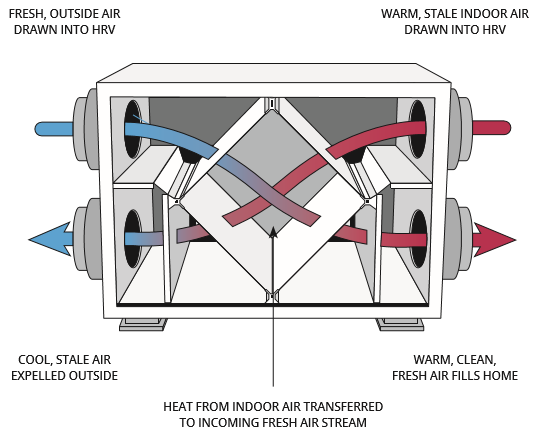Discovering the Benefits of Heat Recovery Ventilation for Energy Performance in Residences
Heat Recovery Ventilation (HRV) systems supply homeowners a sensible approach to boosting energy efficiency. By redeeming warm from outgoing air, these systems can substantially lower cooling and heating expenses. Additionally, they give a constant supply of fresh air, boosting interior air top quality and convenience levels. As property owners take into consideration sustainable options, understanding the nuances of HRV systems becomes increasingly vital. What aspects should one examine before making such an investment?
Recognizing Heat Recovery Ventilation Equipments

Just How HRV Enhances Indoor Air High Quality

Power Savings: The Monetary Advantages of HRV
Maximizing power efficiency, heat recovery ventilation (HRV) systems supply considerable monetary advantages for house owners. By recouping and reusing warmth from exhaust air, HRVs significantly decrease home heating and cooling expenses. This modern technology can bring about power cost savings of approximately 30%, relying on climate and use patterns. House owners usually discover minimized utility bills shortly after setup, making HRVs an economically wise investment in time. Furthermore, many areas supply rewards or check these guys out rebates for energy-efficient upgrades, additionally improving the economic charm. As energy costs continue to increase, the cost-effectiveness of HRVs ends up being progressively clear. Overall, the incorporation of HRV systems not just advertises energy effectiveness however also adds to long-lasting monetary savings for houses.
The Environmental Influence of Heat Recovery Ventilation
A significant ecological benefit of heat recovery ventilation (HRV) systems lies in their capability to minimize total power intake. By reclaiming heat from exhaust air and moving it to inbound fresh air, HRV systems decrease the requirement for energy-intensive home heating and cooling down techniques. This decrease in energy need adds to lower greenhouse gas emissions, as much less nonrenewable fuel source is required to preserve comfy interior temperatures. Furthermore, HRV systems enhance indoor air quality by effectively exchanging stale air with fresh outside air, lowering reliance on mechanical cooling systems that can hurt the setting. In general, the application of HRV systems supports sustainable living practices and aligns with global efforts to battle environment modification by advertising power effectiveness in household settings.
Picking the Right HRV System for Your Home
Exactly how can property owners assure they choose the ideal heat recovery ventilation (HRV) system for their see here requirements? First, they should assess their home's dimension and design, as these variables influence air flow demands. Next, examining the system's performance scores is vital, as greater ratings suggest far better performance and energy financial savings. Property owners ought to also consider installation and upkeep expenses, comparing various brand names and models for value. In addition, it is essential to review noise levels, as some systems operate even more quietly than others. Consulting with a/c experts can provide customized suggestions based on certain home conditions. Lastly, examining individual evaluations and warranties can help in making an educated decision, ensuring that the picked HRV system effectively improves interior air top quality and power effectiveness.
Frequently Asked Questions

Exactly how Commonly Should I Tidy or Keep My HRV System?
The frequency of cleansing or preserving a warm recuperation ventilation (HRV) system usually depends on usage and ecological aspects. Generally, it is advisable to execute maintenance every six months to assure peak efficiency and air top quality.

Can HRV Solutions Help In Reducing Humidity Levels Inside?
HRV systems can properly minimize indoor humidity degrees by exchanging stagnant, humid air with fresh, drier air from outside. HRV Heat Recovery Ventilation. This process assists preserve a well balanced indoor atmosphere, boosting convenience and stopping moisture-related concerns
What Is the Life expectancy of a Normal HRV System?
The lifespan of a typical heat recovery ventilation (HRV) system differs, read the article usually lasting between 10 to 15 years. Regular upkeep can extend its efficiency and functional life, making sure peak efficiency throughout its usage duration.
Exist Any Kind Of Sound Interest In HRV Systems?
Noise worry about HRV systems can arise, particularly from follower operation. Nonetheless, several contemporary units are created to lessen audio degrees, guaranteeing they operate silently while preserving effectiveness, which resolves possible disturbances in living environments.
Can I Install an HRV System Myself, or Do I Need a Professional?
The individual contemplated whether to mount the heat recovery ventilation (HRV) system directly or work with an expert. Typically, while DIY installment is possible, experience guarantees appropriate functionality and conformity with regional building ordinance, boosting system effectiveness.